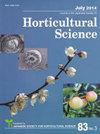Skin Browning and Expression of PPO, STS, and CHS Genes in the Grape Berries of ‘Shine Muscat’
Journal of The Japanese Society for Horticultural Science
Pub Date : 2014-04-01
DOI:10.2503/JJSHS1.CH-095
引用次数: 17
Abstract
A recently popular Japanese yellow-green-skin table grape, ‘Shine Muscat’ (Vitis labruscana Bailey × V. vinifera L.), has the problem of berry skin browning, which occurs at the maturation stage just before harvest. Tiny reddish-brown blotches appear on the surface of berries and considerably decrease the grape’s market value. Although the mechanisms and factors for browning are unknown, we hypothesized the involvement of polyphenol compounds and their oxidation reactions. In this study, the gene expressions of polyphenol oxidase (PPO), stilbene synthase (STS), and chalcone synthase (CHS), which are key enzymatic genes related to the metabolic pathway for polyphenols, were analyzed during berry maturation to examine the molecular basis for browning. Skin browning occurred on several berries in a bunch of ‘Shine Muscat’ from 80 days after full bloom (DAFB), after which the number of berries with skin browning increased, and the browned area spread on the berry surfaces with maturation. Increases in the expression of VvPPO2, VvSTS type B, and VvCHS1 were associated with skin browning, and the trans-resveratrol content also increased in the browning skin, suggesting that biosynthesis and metabolic pathways for phenolic compounds were activated at the time of browning. In terms of VvPPO genes, specific up-regulation of VvPPO2 expression was observed compared with the VvPPO1 gene. The promoter sequence of VvPPO2 contains more Myb binding motifs and W-box motifs than does VvPPO1. The specific up-regulation of VvPPO2 gene expression will play a crucial role in understanding and managing the skin-browning mechanism in the grape berries of ‘Shine Muscat’.‘Shine Muscat’葡萄果实表皮褐变及PPO、STS、CHS基因的表达
最近流行的一种日本黄绿色的鲜食葡萄“Shine Muscat”(Vitis labruscana Bailey × V. vinifera L.),在收获前的成熟阶段就会出现浆果皮变褐的问题。浆果表面出现小的红褐色斑点,大大降低了葡萄的市场价值。虽然褐变的机制和因素尚不清楚,但我们假设多酚化合物及其氧化反应参与其中。本研究分析了多酚氧化酶(PPO)、二苯乙烯合成酶(STS)和查尔酮合成酶(CHS)这三个多酚代谢途径的关键酶基因在浆果成熟过程中的表达,探讨了浆果褐变的分子基础。从开花后80天开始,“Shine Muscat”系列中有几个浆果出现了皮肤褐变,之后皮肤褐变的浆果数量增加,随着浆果成熟,棕色区域扩展到浆果表面。VvPPO2、VvSTS B型和VvCHS1表达的增加与皮肤褐变有关,褐变皮肤中反式白藜芦醇含量也增加,提示褐变过程中酚类化合物的生物合成和代谢途径被激活。在VvPPO基因方面,与VvPPO1基因相比,VvPPO2基因的表达特异性上调。与VvPPO1相比,VvPPO2的启动子序列包含更多的Myb结合基序和W-box基序。VvPPO2基因表达的特异性上调将在理解和管理“Shine Muscat”葡萄果实褐变机制中发挥关键作用。
本文章由计算机程序翻译,如有差异,请以英文原文为准。
求助全文
约1分钟内获得全文
求助全文
来源期刊
自引率
0.00%
发文量
0
审稿时长
>36 weeks

 求助内容:
求助内容: 应助结果提醒方式:
应助结果提醒方式:


